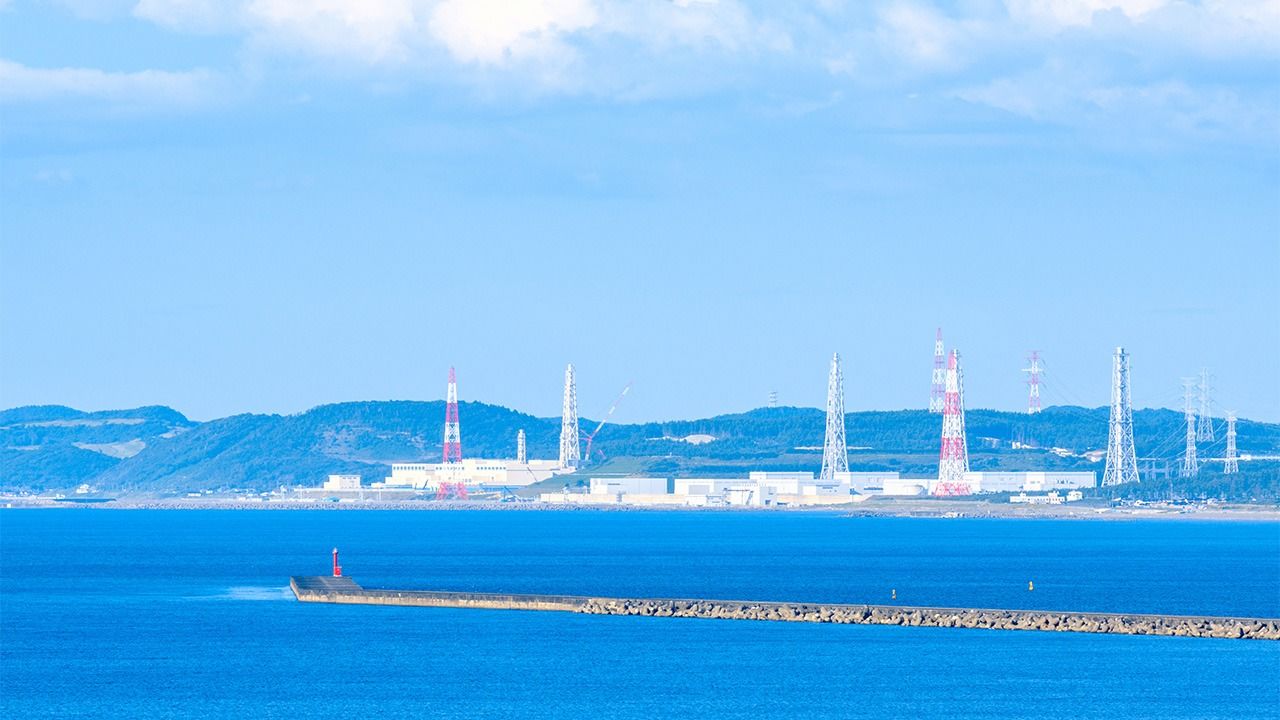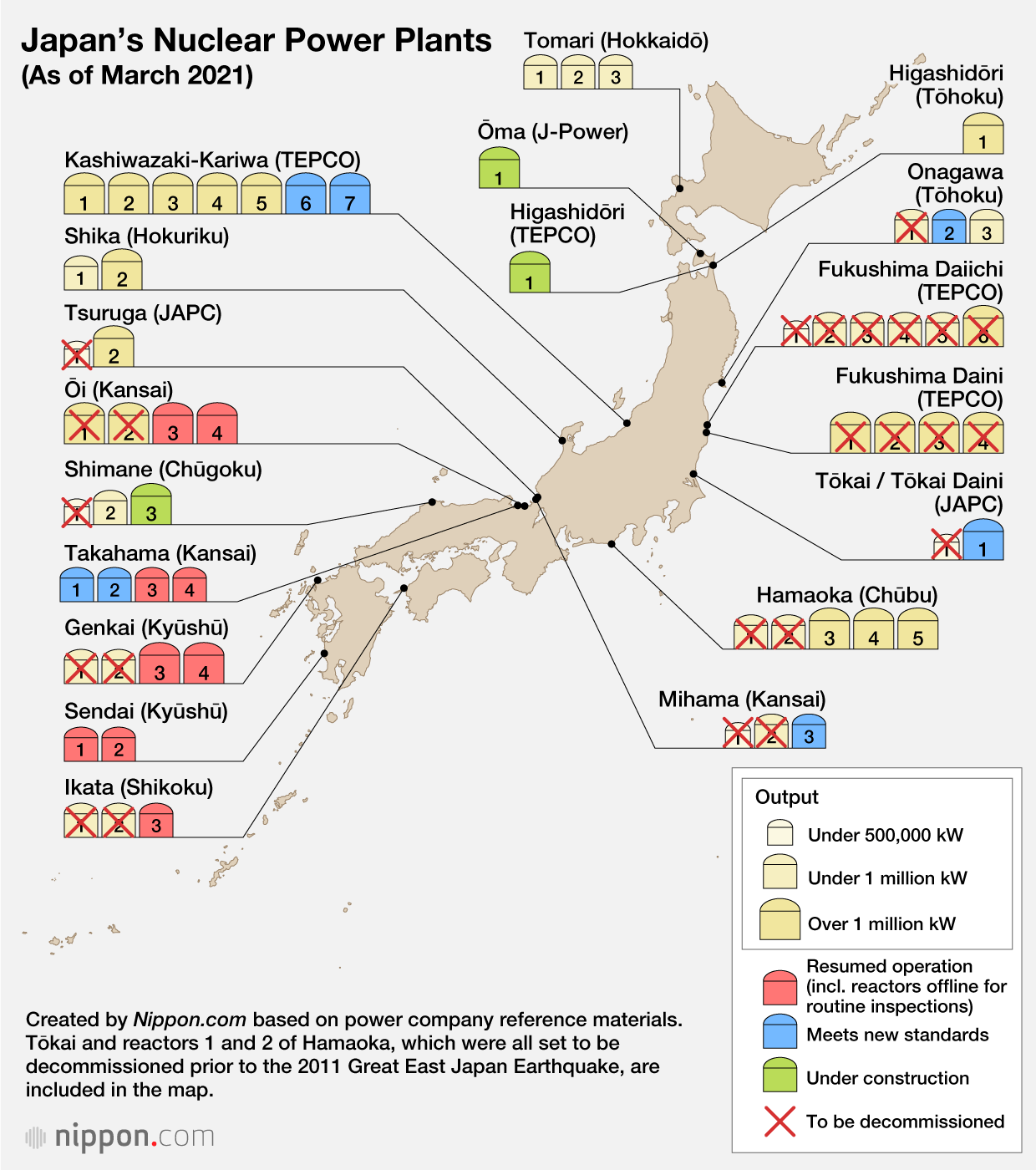
Japan’s Nuclear Power Plants in 2021
Society Economy- English
- 日本語
- 简体字
- 繁體字
- Français
- Español
- العربية
- Русский
Prior to the Great East Japan Earthquake of 2011, 54 nuclear reactors were in operation in Japan, supplying approximately 30% of the country’s electric power. However, the disaster at the Fukushima Daiichi Nuclear Power Plant caused increased distrust and unease toward nuclear reactors and led to a drastic change in how they are regarded.
As of March 2021, 10 years after the accident, only five plants with a total of nine reactors have gained the agreement of local residents to resume operations: Ōi and Takahama (Kansai Electric Power Company), Genkai and Sendai (Kyūshū Electric Power Company), and Ikata (Shikoku Electric Power Company). These plants are all based in western Japan and are pressurized water reactors, which differ from the Fukushima Daiichi plant with its boiling water reactors. Since the 2011 disaster, Japan’s power companies have decided to decommission a total of 21 reactors.
In November 2020, Miyagi Governor Murai Yoshihiro announced that he had agreed to the restarting of the No. 2 reactor at Onagawa Nuclear Power Plant (Tōhoku Electric Power Company). The plant suffered damage in the earthquake, including the outside heavy oil storage tank collapsing and the cooling system being flooded. Moreover, because it is the same BWR system as the Fukushima Daiichi plant, there is deep-rooted wariness among local residents. Conversely, operation of the power plant creates local jobs and the authorities can expect income to increase through nuclear fuel tax and property tax, so the governor said that he agonized over the decision right up until giving approval.
Meanwhile, it was discovered that the intruder detection system at Kashiwazaki-Kariwa Nuclear Power Plant (TEPCO) had not been functioning since March 2020. On March 16, 2021, the Nuclear Regulation Authority assessed that this was the most serious risk level on its four-point scale as it could have been a very grave situation regarding the security of nuclear material. The plant has had a series of scandals, including an employee using another employee’s ID card to enter the central control room in September 2020. TEPCO had been aiming to restart the Kashiwazaki-Kariwa plant as a key site for improving its profitability; however, the frequent scandals mean it will be difficult to gain local approval.
Nuclear Power Plants: Major Developments Since the Great East Japan Earthquake
| March 2011 | Great East Japan Earthquake and TEPCO Fukushima Daiichi Nuclear Power Station accident. |
| May 2012 | Tomari Nuclear Power Plant (Hokkaidō Electric Power Company) suspends operation of its No. 3 reactor and for the first time in 42 years there are no nuclear power plants operating within Japan. |
| June 2012 | The operating period of nuclear power plants is limited to 40 years in principle. |
| July 2012 | No. 3 and No. 4 reactors at Ōi Nuclear Power Plant (Kansai Electric Power Company) resume operation (ending a 2-month period of no nuclear power generation in Japan). |
| September 2012 | Nuclear Regulation Authority established. |
| July 2013 | New regulatory standards relating to natural disasters and terrorist attacks introduced for nuclear power plants. |
| September 2013 | No. 3 and No. 4 reactors at Ōi Nuclear Power Plant undergo regular inspection and nuclear power generation drops back to zero. |
| April 2014 | The cabinet approves the fourth energy basic plan, positioning nuclear power plants as an important base-load power source, while also pledging to reduce dependency on nuclear power as much as possible by introducing renewable energy. |
| August/October 2015 | No. 1 and No. 2 reactors at Sendai Nuclear Power Plant (Kyūshū Electric Power Company) resume operation. These are the first restarts since the introduction of the new standards and follow almost two years without nuclear power. |
| January/February 2016 | No. 3 and No. 4 reactors at Takahama Nuclear Power Plant (Kansai Electric Power Company) resume operation. |
| August 2016 | No. 3 reactor at Ikata Nuclear Power Plant (Shikoku Electric Power Company) resumes operation. |
| March/June 2018 | No. 3 and No. 4 reactors at Ōi Nuclear Power Plant resume operation. |
| March/June 2018 | No. 3 and No. 4 reactors at Genkai Nuclear Power Plant (Kyūshū Electric Power Company) resume operation. |
| July 2018 | The cabinet approves the fifth energy basic plan with the intention to have nuclear power account for 20-22% of power generation in 2030. |
| November 2020 | Miyagi Governor Murai Yoshihiro gives approval for Onagawa Nuclear Power Plant (Tōhoku Electric Power Company) to resume operation. This is the first approval for a boiling water reactor, the same type as at the Fukushima Daiichi plant where the accident occurred. Tōhoku Electric Power Company aims to start operation after fiscal 2020. |
| December 2020 | Osaka District Court rules to cancel permission to resume operation of No. 3 and No. 4 reactors at Ōi Nuclear Power Plant (the Japanese government appeals). |
| January 2021 | It is discovered that there was unauthorized use of an employee ID card to enter the central control room at Kashiwazaki-Kariwa nuclear power plant (TEPCO) in September 2020. |
| March 2021 | The Nuclear Regulation Authority announces that the intruder detection system at Kashiwazaki-Kariwa Nuclear Power Plant had not been functioning since March 2020 and that adequate alternative measures were not taken. |
(Originally published in Japanese and most recently updated on March 18, 2021. Banner photo: Kashiwazaki-Kariwa Nuclear Power Plant in Niigata Prefecture. © Pixta.)
